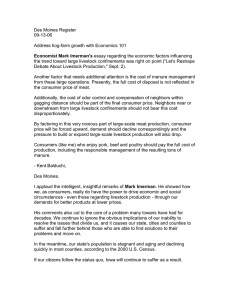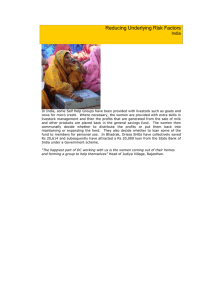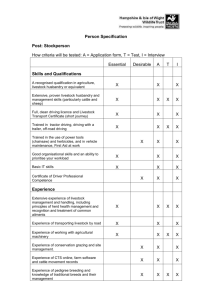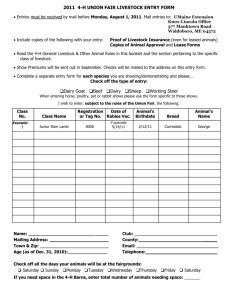Sustainable livestock. For people, for the planet
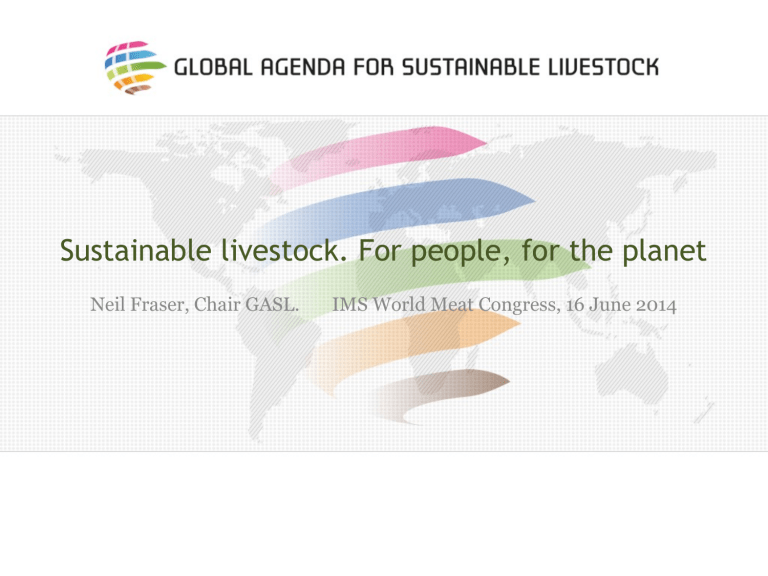
Sustainable livestock. For people, for the planet
Neil Fraser, Chair GASL. IMS World Meat Congress, 16 June 2014
Global contributions of the Sector o Supports livelihoods
1 billion poor, 40% of agricultural GDP, 3.5% annual growth o Food security and nutrition
26% of global protein consumption, 13% calories, critical micronutrients o Economic development
Poverty reduction, income increase, international trade o Other services
Fertilizer, draught, fibre, household capital reserve, by-products
Use of Global Resources o Livestock as users of global resources
• Energy, nutrients, land, water
• Grazing occupies 26% of earth’s land surface
• 33% of cropland for livestock feed o Externalities
• GHG emissions – 14.5% of global total
• Nutrient emissions – water quality
• Overgrazing/land degradation?
• Biodiversity +
• Land use change
Million tonnes
Meat
Source: FAOSTAT
Eggs
Million tonnes
Milk
Livestock in development o Employ 1.3 billion people o Provide livelihoods for 1 billion poor – 70% women o Account for 40% of global agricultural GDP o Ten times more women own livestock rather than land
Global poverty and inequality needs to be addressed through livestock
Livestock in development o 70% of emerging human diseases are of animal origin o Provide 26% of global protein consumption o Contain micronutrients essential to the development of human o cognitive functions
Global food security and health needs
health risks
to be addressed through livestock
Livestock in development o 14.5 % of total Greenhouse Gas emissions – large mitigation potential o 26% of all land is used for grazing; 33% of cropland for livestock feed o Pose a threat to biodiversity in 306 of the 825 ecoregions
be addressed through livestock
Resolution
For a sustainable livestock sector, there is…
• No single answer - diversity of contexts and systems
• No single organization
• No single stakeholder group
Instead, there is a need for collective, concerted and global action
Nature of the Global Agenda for Sustainable Livestock o Multi-stakeholder partnership o Open and voluntary o Inclusive and consensual o Direction of change o Knowledge based o Respect
The Agenda – joint activities o Facilitate multi-stakeholder dialogue at international, national and local level
• Stimulate multi-stakeholder interaction and sharing of knowledge;
• Build consensus on priority issues and actions. o Implement and support joint analyses and assessments
• Conduct analyses to enhance joint understanding on livestock sector sustainability;
• Develop harmonized metrics and methodologies (LEAP, GLEAM);
• Identify entry points for sector improvement.
The Agenda – joint activities
(cont) o Provide strategic sector guidance
• Inform inter-governmental and other partnership processes;
• Work towards policy and operational coherence; o Promote and support innovation and local practice change
• Catalyze innovation and investment in sustainable sector development
Concurrently addresses o Global food security and health: The Agenda promotes an inclusive approach to managing disease threats at the animal-human-environment interface, that involves all sector stakeholders at every level in the development and implementation of animal-disease and food-safety programmes.
o Equity and growth: The Agenda supports a viable growth in value chains that have access to all necessary resources and services, and in which the poor can find secure livelihoods and participate in growing markets or take up other opportunities outside the sector.
o Resources and climate: The Agenda promotes livestock production based mainly on materials not competing with direct use as human food. It supports environmental stewardship through incentives and rewards to allow the sector to transition to existing and new resource use efficient ways of production, and a greater contribution to climate change mitigation.
Composed of
Stakeholder clusters
Public Sector
Private
Sector
Research
NGOs
Social movements
Donors
Global Multi-Stakeholder Platform
Guiding Group
(with exec. com)
Support
Team
Concurrently addresses
Issues
Food security and Health
Equity and
Growth
Resources and Climate
Efficiency
Grassland
Waste
Pilot MSPs
Region
Country
The Agenda – In shorthand o Multi-stakeholder partnership committed to sustainable livestock sector development o Continuous improvement o Simultaneous addresses three BIG challenges of our time
• Climate and Resources
• Equity and Growth
• Food security and Health o Addresses unprecedented challenges o Unites the forces of all sector actors o Focuses on themes with a high potential for change o Informs, guides and catalyzes practice change o Supports innovation and investment in viable sector solutions
Thank you
Sustainable livestock. For people, for the planet
Join us to change together
